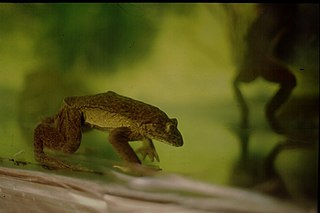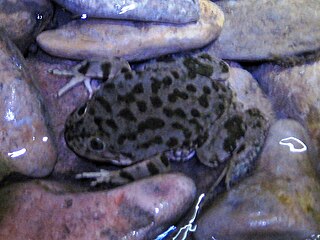 W
WTelmatobius is a genus of frogs native to the Andean highlands in South America, where they are found in Ecuador, Peru, Bolivia, northwestern Argentina and northern Chile. It is the only genus in the family Telmatobiidae. Some sources recognize Batrachophrynus as a valid genus distinct from Telmatobius.
 W
WTelmatobius atahualpai is a species of frog in the family Telmatobiidae. It is endemic to the Cordillera Central of northern Peru and found in the San Martín and Amazonas Regions at 2,600–4,000 m (8,500–13,100 ft) asl.
 W
WTelmatobius culeus, commonly known as the Titicaca water frog, is a medium-large to very large and endangered species of frog in the family Telmatobiidae. It is entirely aquatic and only found in the Lake Titicaca basin, including rivers that flow into it and smaller connected lakes like Arapa, Lagunillas and Saracocha, in the Andean highlands of Bolivia and Peru. In reference to its excessive amounts of skin, it has jokingly been referred to as the Titicaca scrotum (water) frog.
 W
WTelmatobius intermedius is a species of frog in the family Telmatobiidae. It is endemic to Peru. Its natural habitats are subtropical or tropical high-altitude shrubland, subtropical or tropical high-altitude grassland, and rivers.
 W
WTelmatobius macrostomus, also known as the Lake Junin (giant) frog or Andes smooth frog, is a very large and endangered species of frog in the family Telmatobiidae. This completely aquatic frog is endemic to lakes and associated waters at altitudes of 4,000–4,600 m (13,100–15,100 ft) in the Andes of Junín and Pasco in central Peru. It has been introduced to slow-moving parts of the upper Mantaro River, although it is unclear if this population still persists.
 W
WTelmatobius marmoratus, the marbled water frog, is a vulnerable species of frog in the family Telmatobiidae. The most widespread species in the genus, it is found in the Andean highlands of Bolivia, northern Chile and southern Peru. It may also occur in northwestern Argentina, but the taxonomic position of this population is unclear. This semiaquatic frog is found in and near streams, rivers, waterfalls, lakes and ponds.
 W
WTelmatobius pefauri is a species of frog in the family Telmatobiidae. It is endemic to extreme northern Chile. It was already feared that this species is extinct, but recent research has suggested that the species is extant at several localities in the Arica y Parinacota Region, albeit at low numbers. Furthermore, morphological and genetic data suggest that Telmatobius zapahuirensis is a synonym of Telmatobius pefauri. Common name Arico water frog has been coined for this species.
 W
WTelmatobius simonsi is a species of frog in the family Telmatobiidae. It is endemic to Bolivia. Its natural habitats are subtropical or tropical moist montane forest, subtropical or tropical high-altitude shrubland, subtropical or tropical high-altitude grassland, rivers, freshwater marshes, arable land, pastureland, rural gardens, heavily degraded former forest, ponds, and canals and ditches. It is threatened by habitat loss. It was named for American scientific collector Perry O. Simons.
 W
WTelmatobius is a genus of frogs native to the Andean highlands in South America, where they are found in Ecuador, Peru, Bolivia, northwestern Argentina and northern Chile. It is the only genus in the family Telmatobiidae. Some sources recognize Batrachophrynus as a valid genus distinct from Telmatobius.
 W
WTelmatobius ventriflavum is a species of water frogs from the western Andes in Peru.
 W
WThe Sehuencas water frog is a species of frog in the family Telmatobiidae. It is endemic to Bolivia. Its natural habitats are subtropical or tropical moist montane forest, rivers, and freshwater marshes. It is threatened by habitat loss. While it is currently listed as vulnerable by the IUCN, this is based on an assessment that has not been updated since 2004. No individuals had been encountered in the wild between 2008 and 2019.